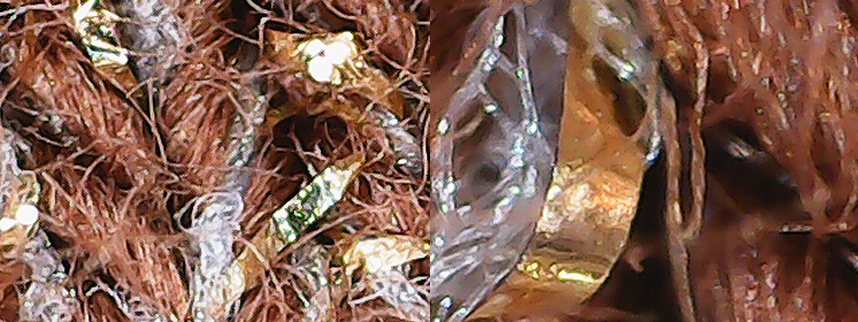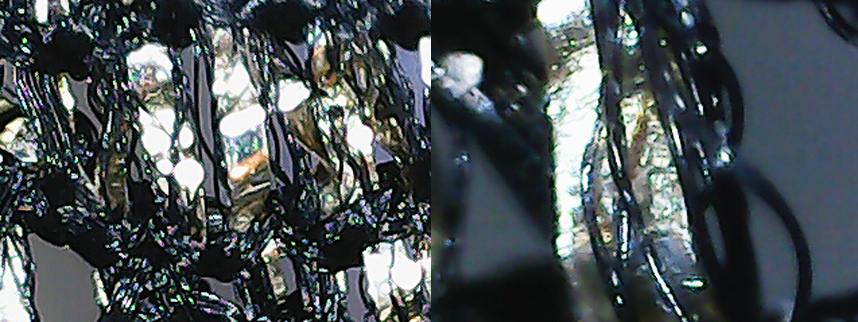A just-for-fun post for you today!
My son received a microscope this Christmas just gone and while we were playing around with it, finding things to zoom in on, we popped a sleeve cuff under the lens and well, that got me to thinking about doing a deep dive on lingerie fabrics. You can read about how jacquard is woven or how smooth nylon is, but actually seeing it? I found it fascinating, and maybe you will too.
Just bear in mind these were all taken on a toy microscope, so the photos it takes aren’t particularly high-resolution. But you can see enough to learn a thing or two, I think.
Stockings & tights
These are ultra-fine, ultra-sheer stockings – much finer-weight than what’s typically sold in stores. How is it achieved? As you can see, they’re knit from incredibly smooth, single-filament threads of nylon (which is a type of polyamide) with very large gaps between them.

These stockings are more opaque than the 5 denier pair, but their individual filaments are actually finer. However, you can see in the closer views that each thread is made up of multiple filaments bundled together for a denser overall effect. Again, the polyamide is completely smooth which is why these types of synthetic-fibre stockings feel so smooth against the skin.

There are supposed to be four different fibre types in the mix here but I can’t say I can differentiate them. You can see how these tights would have much more of a soft, ‘fuzzy’ hand than the smooth stockings above.

Here, although I don’t know the exact fibre contents, I can definitely see three fibre types: the ‘base’ fibre, whatever that is, plus elastane (the clear filaments, also known as spandex) and strips of a flat metallic material woven in for the glittery effect.
Tulle, lace & embroidery
This is a stretch tulle with a very uniform, geometric appearance. You can see some broken elastane fibres poking out; these miniscule bits of damage are practically invisible to the naked eye but it’s what happens to stretch fabrics over time – they wear out.
In this lace, you can more clearly see how the stretchy elastane fibres are woven in with the other threads to give the fabric its flexibility.
This is a finer-quality lace, made on an antique Leavers loom in France. Unlike the lace and tulle above, it’s all one fibre – no elastane. It’s also a corded lace, meaning the floral pattern is outlined in a thicker thread for a slightly raised effect; on the right, you can see one of those thicker threads.
Here, you can clearly see the colourful embroideries weaving in and out of the tulle backing, which is made from a much finer-weight yarn.
Lace and embroidery are not the same thing. Whereas lace is woven/knit/braided into existence from scratch, with embroidery, there is an existing base fabric which the design is embroidered onto. It’s why the majority of lace is a single colour since it would be challenging to switch yarns when you’re using them in one continuous length, whereas it’s common to see multi-coloured embroideries or, as in these examples, an embroidered pattern on a very fine background meant to ‘disappear’ against the skin.
Metallic fabrics

Here’s another example of lace, but one where you can see metallic filaments woven in with the (nylon and elastane) base threads. The gold here isn’t found througout the lace, it’s used to highlight specific floral motifs in the pattern.

This, on the other hand, is an all-over gold lace and the shiny-everywhere effect has been achieved by using nothing but metallic yarn throughout. On the garment, all you see is gold. Under the microscope however you can see that the yarn has an inner core wrapped up in a metallic outer. Interestingly, I noted in the review of this bra set that the lace was prone to unravelling and developed a somewhat messy, frayed look after some wear, and now I understand why!
A non-lace example of a metallic fabric, you can see in the review photos linked above that this fabric looks primarily silver. Up close however, you can see that it’s actually mostly black; I’m going to hazard a guess that the thin silver ‘ribbons’ woven through the fabric are the 1% polyester listed in the fabric contents.
Silk fabrics, plus a synthetic satin comparison
Satin is a type of weave in which the weft (horizontal) yarn passes over multiple warp (verticle) yarns before going under one, and then repeats. It means the top side of the fabric has lots of long, straight lengths of yarn visible, which is what gives the satin its smooth, light-reflecting finish.
You can make satin out of different fibres. However, the smoother the fibre type, the smoother (and shinier) the end result. When you take a less-smooth fibre such as cotton and follow this weave pattern, the end result will have a bit of a glossy sheen to it but not to the same extent as when using, say, silk, so it’s generally referred to as sateen instead of satin.
Here, you can clearly see that weave structure with long, straight lengths of yarn all going in the same direction. The silk fibres themselves are very smooth.

This is a synthetic version of satin, but you can see that the weave pattern is the same, and the polyester fibres are also pretty smooth. Under a microscope, I can’t personally tell the different between silk satin and polyester satin (at least based on these two examples). I assume that the reason polyester satin doesn’t have quite the same fluid drape as the silk satin does is because the polyester fibres themselves are more inflexible.
Like the silk satin, this fabric is 100% silk. However, you can see that the weave is completely different. While this fabric has a slight lustre if you angle it just right under the light, due to the silk fibres’ own light-reflecting structure, it’s definitely not shiny.

This is another pure silk fabric, and one that’s not shiny in the slightest. It’s also sheerer than both the solid satin and the slightly-sheer georgette, due to the openness of the weave. So once again: same fibre, different weave, completely different fabric.
Plant-based fabrics

Right: Cotton and modal blend jersey from my Love Suze NoHo set. 55% cotton, 40% modal, 5% elastane.
This are both stretchy cotton-based jerseys, the red one a mix of cotton and modal (modal is a semi-synthetic fabric made from beech tree pulp). You can see that they have been knit, not woven, and that the general texture is a little fuzzy rather than ultra-smooth. Both of these fabrics have a very soft hand.

Both of these fabrics are braided. Tencel, like the modal above, is a semi-synthetic fabric made from wood pulp. Once again, you can see their fuzzy texture under the microscope, even though they don’t look at all fuzzy to the naked eye (in the way that, say, mohair does).

Not lingerie, sorry! I don’t have any linen lingerie (yet… Seelanii’s linen pieces are on my wishlist) but I wanted to include one more example of a plant-based fibre, so you can really see how these tend to have a bit more texture to them compared to the perfect uniformness of many of the synthetics – such as the example just below.
Synthetic fibre fabrics
This knicker has a very light ribbed texture, and you can see exactly how it’s structured to create that under the microscope. The fabric is 100% synthetic, and look how neat and smooth it all looks compared to the natural or semi-natural fabrics above. As a fabric, it does feel incredibly soft and smooth.
Compare this jersey, which is 100% synthetic, to the red Love Suze cotton-blend jersey above, which contains natural fibres. Once again, you can see how the synthetic fibres create a smoother, more uniform surface. They’re both smooth fabrics, but I think the best way to describe the difference is that the synthetic one is the sleekest while the one with natural fibres has a cosier touch.
Other fabrics
It’s hard to make out what’s going on with velour because it’s a pile fabric (think of a shag rug) and the base weave is hidden beneath that dense abundance of fibres. The right image shows the edge of a hemline. It’s this mass of fine, cut fibres that gives the velour both its thickness and its soft, brushed texture.
With jacquard fabrics, rather than a pattern being printed, embroidered or otherwise added onto an existing fabric, a special loom (invented by Joseph Marie Jacquard) weaves in the pattern directly while the fabric is being produced. You can see how the weave here isn’t uniform – there are threads going in all different directions, which will reflect light differently and hence create a visible pattern. You can see the finished result in the image at the very top of this article.
I did look at some other materials from within my lingerie collection too (scuba jersey, elastic bra straps, even an organza storage bag…) but I didn’t think they were as interesting. If there’s a particular fabric or fibre type I’ve left out though that you’re curious about, let me know and if I have it, I’ll take a picture and reply to your comment.
What did you find most interesting or surprising from these photos?
